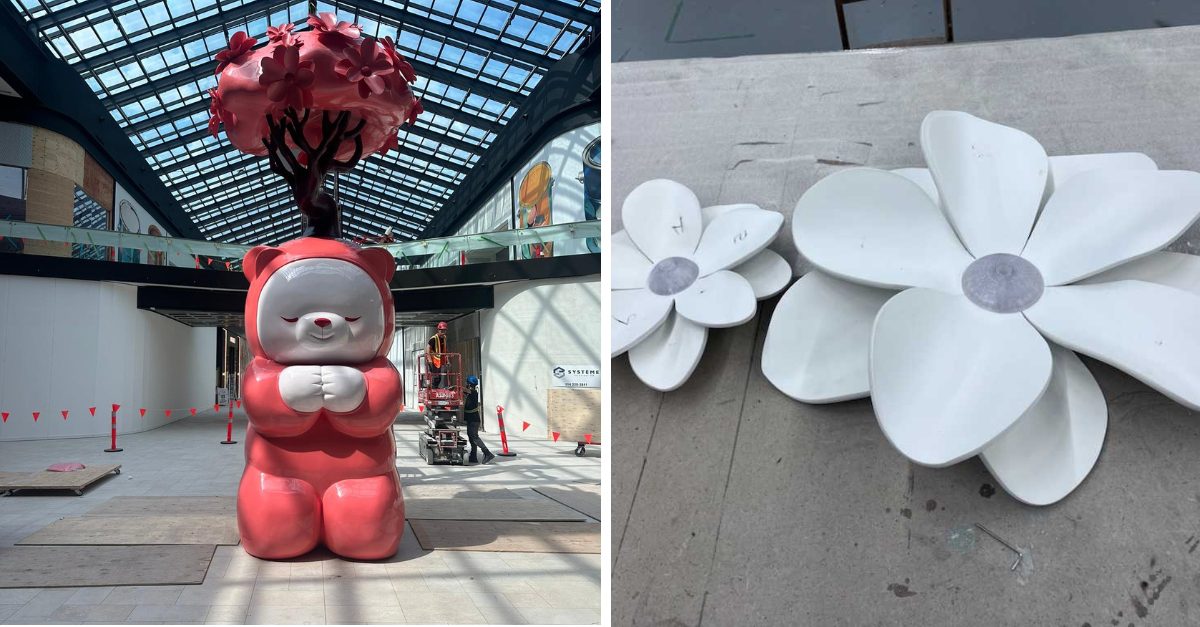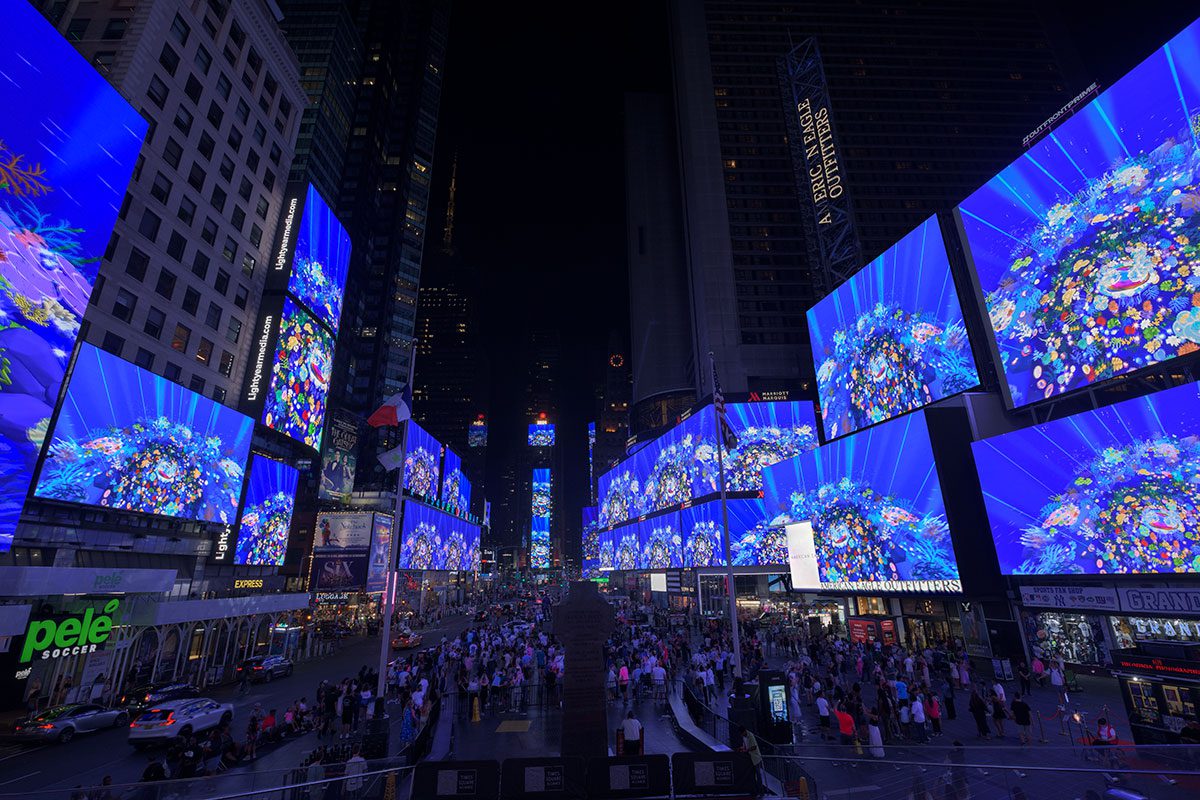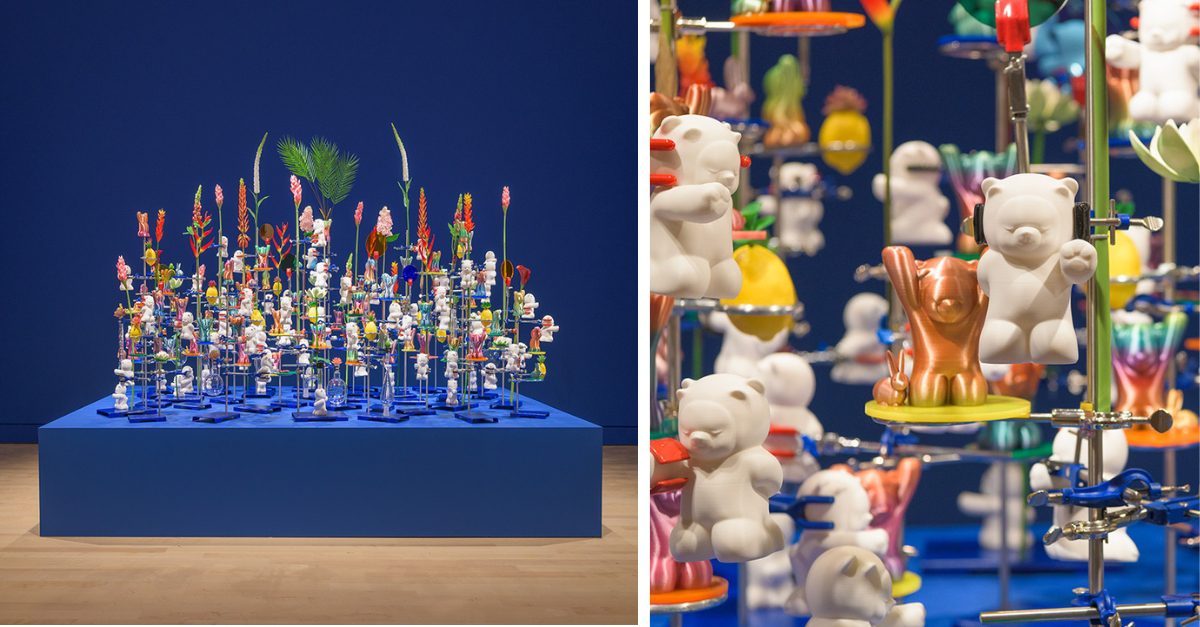Home /
In this vast, two-level development spanning 824,000 sq ft, Carbonleo embraces a vision of fostering human connection through a creative strategy that stands apart from other developments by prioritizing community. This vision aligns seamlessly with MASSIVart’s commitment to bringing places to life through art and culture.
We are proud to have overseen the curation, fabrication, and installation of Chun Hua Catherine Dong‘s first large-scale sculpture, marking a significant milestone in her artistic journey. The artwork has been fabricated in collaboration with Studio Artefact and Fibromoule.
In this Q&A, Chun Hua shares insights into her artistic evolution, the themes that drive her work, and the role of public art in addressing societal issues. We invite you to delve into her reflections and discover how her contributions transform Royalmount into a vibrant cultural landmark.

‘The Wishing Bear’ – Chun Hua Catherine Dong
When I was a child, I loved drawing and dreamed of becoming an artist, but I didn’t have the opportunity to pursue this dream because my family was very poor. Moving to Canada in my 20s felt like a new beginning, and I asked myself what I would do with this fresh start. Naturally, I wanted to revive my childhood dream. I enrolled at Emily Carr University of Art & Design, initially thinking I would become a painter. In a sculpture class, I created a sculpture that seemed very boring and poorly made. To make it more interesting, I decided to perform actions with it, using my body to engage with the sculpture. This was my first time exploring performance art, even though I didn’t know what it was at the time. The experience was absolutely liberating, and I felt that I had finally found a way to express myself authentically. This discovery set me on a path of artistic exploration and self-discovery that continues to inspire my work today.
These themes are deeply connected to my personal experience and my life back in China. Living in a different cultural context often prompts questions about one’s identity. If I had stayed in China, I might never have felt the need to confront these issues. However, I immigrated to Canada a long time ago and now find it necessary to reconnect with my roots because something that nurtured me has faded and been forgotten. Renewing this connection from time to time is important to me. In terms of mediums, I have a wide-ranging interest and enjoy experimenting with new forms. Sticking to a single medium for too long bores me; I need to try new things to stay excited and challenged. This constant exploration keeps me learning, but it also means I don’t feel like an expert in any one medium. I’m always evolving, which is both a strength and a challenge.

‘Mulan’ – Chun Hua Catherine Dong, Times Square, New York
“The Yellow Umbrella – An Unfinished Conversation” and “Husbands and I” are my earlier performance pieces. Since the term “public art” encompasses a range of perspectives and mediums, performances can be regarded as public art. In addressing and challenging societal issues through public art, artists play an important role in shaping public consciousness and provoking thought and reflection. When I create ephemeral works like performances or performance interventions in public spaces, I often view these spaces as playgrounds, stages, or instruments for unsanctioned artworks, activist interventions, and political actions. This type of public artwork can be very political but offers different perspectives on what public art can be.
Integrating art into public spaces holds significant importance for cultural engagement and community building. Public art makes art accessible, allowing people from diverse backgrounds to experience and engage with art in their daily lives. It often serves as a symbol of the community and can become a central gathering point. It provides common ground where people can come together, share experiences, and engage in conversations. Public art also helps build a unique identity for a local community by transforming mundane or neglected spaces into visually stimulating environments. This transformation can define the character of a place, making it distinctive and memorable.

‘Out of the Blue’ – Chun Hua Catherine Dong
Public art can be a powerful medium for addressing and highlighting societal issues. It achieves this through the use of symbols, storytelling, and gestures that foster empathy and understanding. When people encounter art that tells the stories of marginalized groups, they are more likely to develop a deeper understanding and compassion for their experiences and struggles. Artists use different mediums to express societal issues they care about. For example, “Fearless Girl” by Kristen Visbal in New York City is a very powerful piece celebrating girl power. It also sparks conversation about gender equality in workplaces.
I envision public art becoming more interactive and dynamic, utilizing augmented reality (AR) and virtual reality (VR) to create immersive experiences. These technologies can make artworks more engaging, allowing viewers to interact with and explore them in new ways. For example, AR could bring historical figures to life or animate static public art, making it feel alive. Additionally, AR can make site-specific public art accessible from anywhere, letting viewers experience it remotely. VR, on the other hand, could transport viewers to different cultural environments, offering a deeper, more immersive understanding of diverse perspectives and histories.
| Cookie | Duration | Description |
|---|---|---|
| cookielawinfo-checkbox-analytics | 11 months | This cookie is set by GDPR Cookie Consent plugin. The cookie is used to store the user consent for the cookies in the category "Analytics". |
| cookielawinfo-checkbox-functional | 11 months | The cookie is set by GDPR cookie consent to record the user consent for the cookies in the category "Functional". |
| cookielawinfo-checkbox-necessary | 11 months | This cookie is set by GDPR Cookie Consent plugin. The cookies is used to store the user consent for the cookies in the category "Necessary". |
| cookielawinfo-checkbox-others | 11 months | This cookie is set by GDPR Cookie Consent plugin. The cookie is used to store the user consent for the cookies in the category "Other. |
| cookielawinfo-checkbox-performance | 11 months | This cookie is set by GDPR Cookie Consent plugin. The cookie is used to store the user consent for the cookies in the category "Performance". |
| viewed_cookie_policy | 11 months | The cookie is set by the GDPR Cookie Consent plugin and is used to store whether or not user has consented to the use of cookies. It does not store any personal data. |